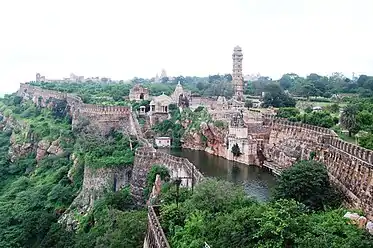Mori Rajputs | |||||||||
|---|---|---|---|---|---|---|---|---|---|
| 700_734 CE.[1][2] | |||||||||
 South Asia 600 CE ◁ ▷ The Moris and neighbouring South Asian polities circa 600 CE.[3] | |||||||||
| Capital | Chittorgarh Fort, Rajasthan, India 24°53′11″N 74°38′49″E / 24.8863°N 74.647°E | ||||||||
| Religion | State religion: | ||||||||
| |||||||||

The Mori was a kingdom that ruled over southwestern Rajasthan and northern Malwa from the 7th century and for a period of about 120 years.[6] They controlled the Chittor Fort. The Mori Rajputs were probably the most powerful power in this region before the rise of the Gurjar Pratihara dynasty.
History
The Mori Rajputs or the Maurya Rajputs are said to be directly descended from the Mauryan Empire. The Mori Rajputs are mentioned as one of the fourteen branches of the Parmar Rajput clan by British scholars.[7][8] Chitrangada Mori, a Mori Rajput ruler, laid the foundation of the fort of Chittorgarh.[9][10][2]
A dynasty belonging to the Mori clan controlled the Chittor Fort and the surrounding region before the Guhila dynasty. The fort of Chittor was a well established citadel in the 8th century under the Moris.[11] The Chittorgarh inscription dated 713 AD gives four names of Mori Rajput rulers of Chittor.[12]
The Chittorgarh inscription dated 713 AD gives four names of Mori Rajput rulers of Chittor.[12] Manuraja is identified with Māna, mentioned in the Chittorgarh Māna-sarovara inscription of 713 AD. Māna was described as the son of Bhoja.[13][14] Māna's great - grandfather was named Maheśvara.[15]
Bappa probably led the Mori campaign against the Arabs, which made him more famous than his overlord. Later, he either deposed Manuraja and became the king of Chittor with the help of the nobles or became the king after Manuraja died childless.[16] The Moris were expelled from Chittorgarh by Bappa Rawal.[17][13]
Defeat by the Arabs
According to C.K. Majumdar, the Moris were ruling at Chittor[18] when the Arabs (mlechchhas) invaded north-western India around 725 CE.[18] The Arabs defeated the Moris, and in turn, were defeated by a confederacy that included Bappa Rawal.[19][20][14]
Decline of Mori Kingdom
King Maan Mori was defeated by Bappa Rawal. Bappa Rawal, defeated his maternal grandfather and captured the kingdom of Chittor. This event is mentioned in the Rajprashasti Abhilekh, in the epic Mahakavya, in Canto 3:[21][22]-
ततः स निर्जित्य नृपं तु मौरी जातीयभूपं मनुराजसंज्ञम्। गृहीतवांश्चित्रितचित्रकूटं चक्रेऽत्र राज्यं नृपचक्रवर्ती॥
— राजप्रशस्ति अभीलेख, महाकाव्य, सर्ग 3
See also
References
- ↑ Parameswaran, Dr S. Pari (13 January 2023). ANCIENT AND MEDIEVAL HISTORY: AN EAGLE'S VIEW FOR CIVIL SERVICES AND OTHER EXAMS. MJP Publisher. ISBN 978-93-5528-240-8.
- 1 2 Guides, Bluworlds; Das, Joydip. Royal Rajasthan Pocket Travel Guide. Bluworlds Guides. Archived from the original on 12 January 2024. Retrieved 19 March 2023.
- ↑ Schwartzberg, Joseph E. (1978). A Historical atlas of South Asia. Chicago: University of Chicago Press. pp. 21, 147. ISBN 0226742210. Archived from the original on 12 January 2024. Retrieved 8 February 2023.
- ↑ Balogh, Dániel (9 December 2018). "Chittorgarh fragmentary inscriptions of the Naigamas, inked rubbing". doi:10.5281/zenodo.2105017. Archived from the original on 12 January 2024. Retrieved 8 February 2023.
{{cite journal}}: Cite journal requires|journal=(help) - ↑ Epigraphia Indica Vol 34. pp. 53–58.
- ↑ Somani, ram Vallabh (1976). History Of Mewar. p. 28.
- ↑ Chand, Faquir; Sinha, N. K. (1992). People of India: Daman and Diu. Popular Prakashan. ISBN 978-81-7154-762-3. Archived from the original on 12 January 2024. Retrieved 19 March 2023.
- ↑ Dikshit, Durga Prasad (1980). Political History of the Chālukyas of Badami. Abhinav Publications. Archived from the original on 12 January 2024. Retrieved 17 August 2023.
- ↑ Singh Chib, Sukhdev (1979). Rajasthan. The University of Michigan. p. 118. Archived from the original on 12 January 2024. Retrieved 19 March 2023.
- ↑ Rajasthan. The University of Michigan. 1962. p. 44. Archived from the original on 12 January 2024. Retrieved 19 March 2023.
- ↑ India Tourism Development Corporation, India Tourism Development Corporation (1975). Guide to Rajasthan. India Tourism Development Corporation. p. 169. Archived from the original on 12 January 2024. Retrieved 19 March 2023.
- 1 2 Rajasthan State Gazetteer, Rajasthan State Gazetteer (1995). Rajasthan State Gazetteer: History and culture. Directorate, District Gazetteers, Government of Rajasthan. p. 322. Archived from the original on 12 January 2024. Retrieved 19 March 2023.
- 1 2 Calcutta Sanskrit College Research Series, Calcutta Sanskrit College Research Series (1965). Calcutta Sanskrit College Research Series. The University of California. p. 52. Archived from the original on 12 January 2024. Retrieved 19 March 2023.
- 1 2 Kumar, Raj (2008). Encyclopaedia Of Untouchables : Ancient Medieval And Modern. Gyan Publishing House. ISBN 978-81-7835-664-8. Archived from the original on 12 January 2024. Retrieved 19 March 2023.
- ↑ Singh, R.B (1975). Origin of the Rajputs. Sahitya Sansar Prakashan. p. 40. Archived from the original on 12 January 2024. Retrieved 19 March 2023.
- ↑ Shyam Manohar Mishra 1977, p. 48.
- ↑ Topsfield, Andrew (2001). Court Painting at Udaipur Art Under the Patronage of the Maharanas of Mewar. Artibus Asiae Publishers. p. 17. ISBN 9783907077030. Archived from the original on 12 January 2024. Retrieved 19 March 2023.
- 1 2 R. C. Majumdar 1977, p. 298-299.
- ↑ Ram Vallabh Somani 1976, p. 45.
- ↑ Khalid Yahya Blankinship 1994, p. 188.
- ↑ Bhatt, Ranchod (1973). Rajprasastia Mahakavyam.
- ↑ Ranchod Bhatt Maharana (1973). Raj Singh Raj Prashasti.
Bibliography
- Khalid Yahya Blankinship (1994). The End of the Jihad State: The Reign of Hisham Ibn 'Abd al-Malik and the Collapse of the Umayyads. SUNY Press. p. 188. ISBN 978-0-7914-1827-7.
- Ram Vallabh Somani (1976). History of Mewar, from Earliest Times to 1751 A.D. Mateshwari. OCLC 2929852.
- R. C. Majumdar (1977). Ancient India. Motilal Banarsidass. ISBN 9788120804364.
- Shyam Manohar Mishra (1977). Yaśovarman of Kanauj. Abhinav. OCLC 557679616.
